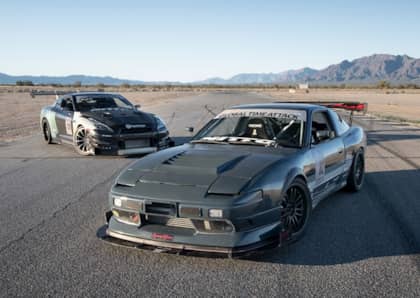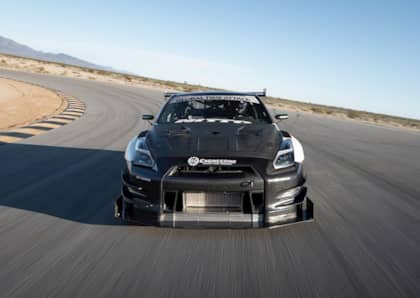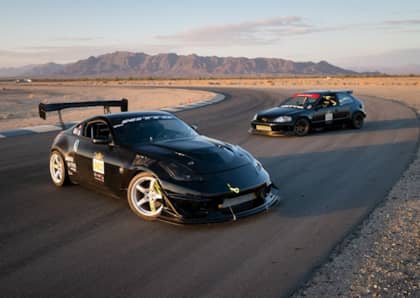Saddling Godzilla: '15 Nissan GT-R Track Car
Godzilla is not a beast to be saddled without experience. Steven Chan had a number of cars and a bunch of seat time before he picked up the 2015 Nissan GT-R seen here. “I started out in autocross well over a decade ago driving a 2004 Mazda RX8. I wasn’t too serious about it at the time, I was just playing around and having fun. Unfortunately, I had stop racing for a number of years because of family problems that I couldn’t avoid,” Chan said. But that didn’t permanently impede him; he quickly got back into racing as soon his family issues cleared up.

“I bought a 2014 Porsche 911 because I liked the look and I thought it would make a good track car. I had it for about a year, but after tracking it a few times I felt it needed more power,” Chan said. His first inclination was to go for the raw power and slick, Italian design of a Ferrari 458. But a European supercar was not in his future. After considerable research, he learned that Nissan’s GT-R R35 readily compared with Ferrari’s 458—which sealed the deal on putting the car in his garage.

Fast Cars Are Not Tamed Overnight
Chan started tracking the car as soon as possible, but he wasn’t the instant star that he expected to be with the new ride. “The first time I had it on the track was frustrating because it wasn’t like the Porsche 911 I used to own. It wouldn’t do what I wanted it to do.” Chan continued, “The GT-R doesn’t drive itself—it’s trickier than other good track cars because it naturally understeers. In order to use the AWD to your advantage on the track you need to understand it and how it works. I started calling the car Godzilla because it was a monster to drive.” He even gave it a Godzilla wrap.

Quickly, Chan become frustrated because he wasn’t clocking the low times he felt he could achieve at the track. It’s difficult for a racer to come to the realization that the car is performing how it should, and that the real problem may be located in the driver seat. Chan’s epiphany happened a few years ago in the exact location where this photoshoot occurred— Chuckwalla Valley Raceway. “I was at the Nissan Challenge track day and I was feeling cocky behind the wheel of my relatively new at the time GT-R. During one of the earlier rounds I was sharing the track with a guy named Steven Doherty in a stock 240SX S13. I figured I’d dominate him on the track without any problem, but during the race he was on my tail, right behind me the whole time. I was totally shocked,” Chan said.
Lesson Learned
The reason that Chan was so shocked was because the 240SX’s 2.4L engine was not considered overpowered with only 150hp available, whereas the GT-R’s turbocharged 3.8L puts out about 600hp. To put that into perspective, Chan had four times the muscle in his GT-R that that Doherty had in the 240SX. Using a little bit of simple math, it’s easy to conclude that the GT-R should have been much faster. Chan learned a valuable lesson from that single race. “Doherty showed me how much the driver matters versus the car,” Chan said. “Doherty and I instantly became friends and I asked him if he would drive my car around the track while I sat in the passenger seat so could see what he did differently than me. That trip around the track changed me.”

After that day at Chuckwalla Chan realized how much he had to learn…and how much faster he could become. “From there I got more schooling, and I became one of Doherty’s disciples. I drove more and I got faster,” Chan said.
Performance Upgrades
Under the tutelage of Doherty, his track times improved. “As I got faster, so did the car, but I stayed away from major power improvements because the car was already plenty fast. I only upgraded to the RD Engineering turbos because I had problems with the factory units.” He did, however, have the internals of the transmission rebuilt with HKS parts to handle the additional power and an EcuTek engine management system.

Other performance improvements included upgraded E85 injectors, a higher capacity fuel pump and an interesting, custom exhaust. “Last year I talked with some of the specialists at Verus Engineering (who manufactures the splitter on the car) about how I could improve the aerodynamics. They suggested that I move the exhaust much higher than the stock location, well above the diffuser.”

Chan took those ideas to Pit Garage where they performed a number of modifications to the car in addition to the exhaust system. “The guys at Pit are great—they fabbed my roll cage, custom splitter mounts, customized power steering cooler, all the air ducts for front bumper and the custom, titanium single-outlet exhaust.”

While he wasn’t into doing a ton of engine performance upgrades, he was not afraid of aero. The aforementioned diffuser was made by Verus Engineering, while the six-inch honeycomb splitter and GT1000 dual element wing were made by APR.
Faster on the Brakes
Everybody has their own method for driving. “With the high-power I have in the GT-R, I’m able to reach top speed faster than most, but I’m on the brakes faster, too,” Chan said. This required some upgrades in the deceleration department. He installed a couple of pairs of four-piston Brembo calipers clamping down on TPM rotors with PMU H21 extreme temperature capability pads for more stopping control.

Chan knew that it didn’t make sense to upgrade brakes without upgrading the tires. Without deliberation, Chan picked a set of Nitto NT01 350/30R20s for their consistency and excellent traction. That Nitto rubber surrounds a pair of 20x11-inch Yokohama RZ-DF wheels in the rear and 20x11-inch Ray’s G25 wheels in the front.

Early tuning of Chan’s Godzilla produced 780hp and 620 lb-ft of torque. Chan interpreted those numbers as, “Just crazy fast on the track.” While it seems that Chan has plenty to be cocky about, the reality is that he’s very friendly and approachable and very fast—just like his instructor.











